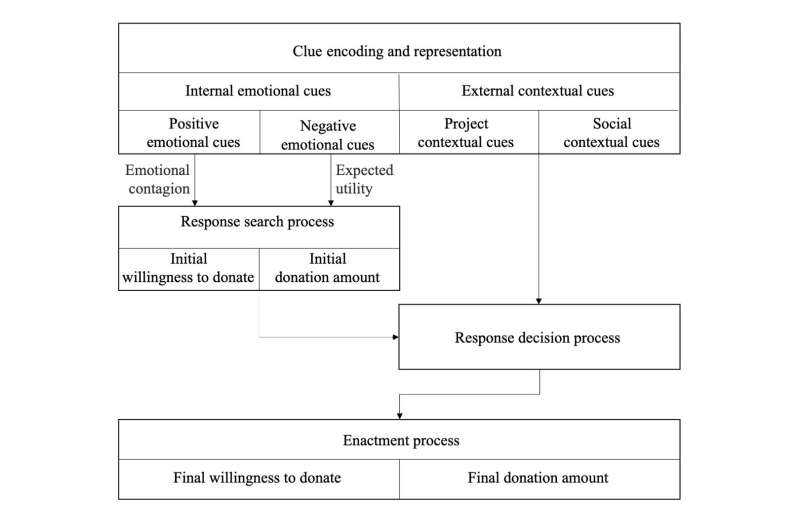This article has been reviewed according to Science X's editorial process and policies. Editors have highlighted the following attributes while ensuring the content's credibility:
fact-checked
proofread
Emotions drive donation behavior in disease relief projects on a fundraising platform: Study

The digital age has profoundly changed how we communicate as humans. Today, we can regularly interact with people we are unrelated to and unacquainted with in real time across the world. Because of this, individuals can now engage in prosocial behaviors, including cooperating, sympathizing, helping and donating, with complete strangers, but the motivating factors behind these behaviors are poorly understood.
Analysis of data generated from a fundraising website suggests that positive emotions elicit higher total donation amounts while negative emotions result in higher individual donation amounts.
Fundraising sites depend on the information provided on their websites to elicit donations to individuals or organizations that donors do not know. Social scientists from Tsinghua University in Beijing, China recently designed a study to determine how internal emotional cues and external contextual cues could influence donating behavior on an online fundraising platform, Tencent Gongyi, in China.
The team collected textual and visual data from 1,763 fundraising projects and performed analyses to assess the emotional state of the faces and text present in each project. The study explored the impact of emotional cues on the behavior of donors and how other factors can influence this process.
The researchers published their study in the Journal of Social Computing.
"Not only in China but also globally, online donations are becoming an increasingly important trend in the charitable sector. The impact of emotional cues on donations is not only a crucial perspective in studying online donation behavior but also a controversial variable in related research. By further introducing contextual factors, our study explored explanatory variables from project characteristics," said Lihan He, first author of the study and doctoral candidate in the School of Public Policy & Management at Tsinghua University.
The researchers developed several hypotheses regarding online donation behavior based on several behavioral theories and past research studies. In the first part of the study, the team hypothesized that positive emotional cues would result in a larger number of total donations, and that negative emotional cues would elicit larger donations from individual donors.
In fact, the study found that projects with pictures with positive emotional cues received at least 1,606 more donations than projects with pictures associated with negative emotions. Projects with negative visual emotional cues also resulted in donations an average of 2.5 yuan higher than projects with pictures that evoke more positive emotions.
The team made additional hypotheses regarding how emotional cues would influence donation behavior depending on the target amounts of each project, first-person pronoun usage, the social class of the recipient and the type of executor that is in charge of each project, such as a government-organized organization, grassroots organization or an individual.
Data analysis revealed that projects with lower target amounts and negative visual emotional cues received an average of two yuan more per donation compared to projects with higher target amounts. The team also found that projects that increased empathy with their audience by using more first-person pronouns like "we" elicited approximately 2,000 more donations if organizers used pictures that result in a positive emotional response and two to four more yuan per donation if organizers used pictures that create a negative emotional response.
The types of executors were more relevant to fundraising projects with grassroots organizers, where campaigns with pictures evoking negative emotions resulted in donations about four yuan higher. If individuals are functioning as executors, projects using pictures that create positive emotions result in an average of 2,532 more donations compared to projects that use images associated with negative emotions.
The team also found that projects that use terms such as "farmer," "worker," "migrant worker" and "rural area" to describe the social class of the recipients had between 1,990 to 2,797 more donations if their project included pictures that elicited a positive emotional response.
"The key takeaway is that individual online donation behavior is complex and shaped by both internal and external factors; therefore, we need richer data and methods to study this behavior. Previous laboratory studies have their advantages but also limitations. If we can obtain more data from the real world and use big data analysis methods, it can help us further test existing theories and discover more interesting influencing factors," said He.
Ultimately, the research team acknowledges that this is only the beginning of analyzing online donation behavior. "This study is a starting point. Currently, there is not a lot of quantitative research on nongovernmental organizations and charity in China, partly due to limitations in data availability. We hope to further integrate computational social science methods with research in this field, engage in more interdisciplinary collaboration and uncover more interesting and meaningful data," said He.
More information: Lihan He et al, How Facial Expressions of Recipients Influence Online Prosocial Behaviors?—Evidence from Big Data Analysis on Tencent Gongyi Platform, Journal of Social Computing (2024). DOI: 10.23919/JSC.2023.0026
Provided by Tsinghua University Press




















